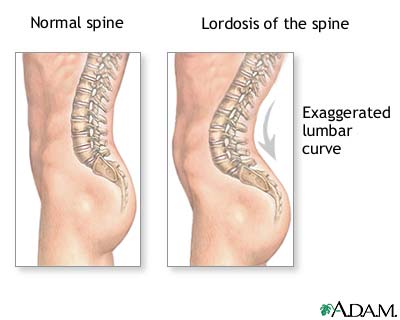Hi guys.
Sorry I haven´t been around for a while. I got a cold and I´m just starting to feel a bit better so i decided to post something 🙂
I saw that the most views I have are for Lordosis ..so i thought you might like some more exercises and some info.
Enjoy!
Lumbar Lordosis is a condition where there is an increased inner curvature of the lumbar spine.Normally a human spine displays some amount of lordosis, but if it increases then it poses a problem for the individual. Lordosis is also known as “swayback.”
Anterior pelvic tilt is the major factor of lumbar lordosis. Due to increased curve of the lumbar spine, lower back puts more pressure on the entire back and this lead to poor movement of the back and lower back pain. It is necessary to keep the curve of the spine in their proper position.
The common factors for lumbar lordosis are tight hip flexors, weak core muscles, weak gluteal muscles, poor form during exercise, etc. The normal curve of the lumbar spine should be approx 30-35 degrees while standing.


How to evaluate if you have lumbar lordosis :
Evaluate the space between the lumbar spine and the wall. When a person has an acceptable degree of lumbar lordosis, you should only be able to slide your fingers behind the lower back up to, and in line with the second or third knuckle of your hand (i.e., where the fingers meet the hand). If the space between the back and the wall is big enough for you to slide your whole hand or arm through, then the client has excessive lumbar lordosis. The greater the space is between the wall and the lower back, the more extreme the deviation or imbalance is.
If someone has a large gluteal complex and the tail bone is not in contact with the wall during the assessment, then you will need to make an allowance for the additional space. Use your best judgment to determine whether the lumbar curvature is excessive.

Lordosis Exercises
The selection of lordosis exercises are based on the imbalance and weakness of the muscle present in your spine. It is very important to address the particular muscle that directly correlates with increased lordosis.
Streches of Hip Flexor
Due to tightness of hip flexor, the opposite groups of muscles (gluteal muscles) become weak and it affects the pelvic alignment. It is important to stretch your hip flexor in order to maintain proper alignment of pelvic and to avoid lumbar lordosis.
Hip flexor can be stretched manually in standing position, bend your knee and hold on to your ankle. When you pull your leg back, tilt your pelvic forward. Hold the stretch position for 25-30 seconds. Please refer to the image to see how this stretch is performed.

Lower Back Muscle Streches
It is important to stretch your back muscle to free from lumbar lordosis. Lie down on the floor on your back, pull your knees slowly into your chest as shown in the image. Inhale with deep breath, when you are performing the exercise. Hold the position for 30-50 seconds.

Abdominal Crunch
Abdominal muscles also play an important role to maintain your posture. Abdominal muscles strengthening exercises help in strengthening the spine and reducing the inward curve. Lie down on the floor facing the ceiling and put your feet on the floor. Tilt your pelvic back by pushing your lower back into the floor. Then lift your torso off the floor to 30 degrees angle, support your neck with your hands. And come back slowly to the starting position. Repeat this exercise 10 times.

Oblique Crunch
Lie down the floor on your back with knees bent and keep feet flat on the floor. Drop your legs to the left side slowly and let your knee rest near the floor. Keep your fingertips to the side of your head behind your ears. Push down your low back into the floor and hold. Then slowly curl up that both your shoulders lift off the floor a few inches. Hold the position for 5 second and return to the start position. Repeat this exercise for 10-15 times. Do the same on the other side.

Hip Extension In The Supine Position
Lay down your back on the floor facing your face upward with the flexion of knees. Keep your feet flat on the floor and apart from each other. Squeeze your gluteus and do slight posterior pelvic tilts to make your lower back flatten. Then lift your hip upward as much you can with squeezing of your gluteus muscles. Hold the position for 10-15 seconds and return to the starting position. Repeat 20 times a day.



Tips To Help Prevention Of Lumbar Lordosis:
- Keep your feet flat on the floor when sitting. Put a small wedge on your chair or adjust your chair to sit so that your knee should be slightly lower than your hip. Support your back lower curve because too much or too little of a curve can cause problems.
- When standing, support your back by resting one leg higher on a step.
- When standing, do not lock your knees straight.
- Keep a flat pillow under your belly if you sleep on your stomach. Sleeping on your back is better with a pillow under your knees.
- Do not wear high heel shoes, your posture will tend to fail. Always wear shoes that provide good support.
- Maintain your buttock muscles and belly (abdominal) strong and firm.
- See your physician if you have persistent or frequent back pain.
Sources: http://www.epainassist.com/
http://www.livestrong.com/